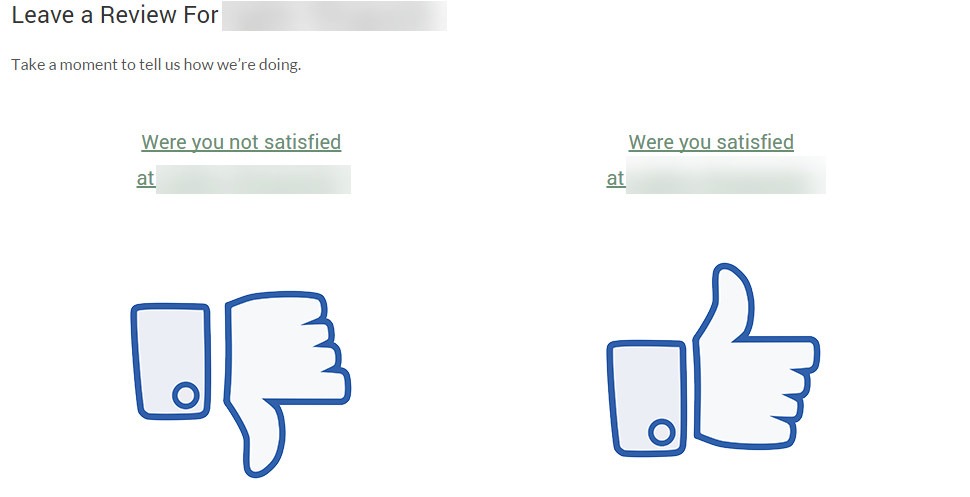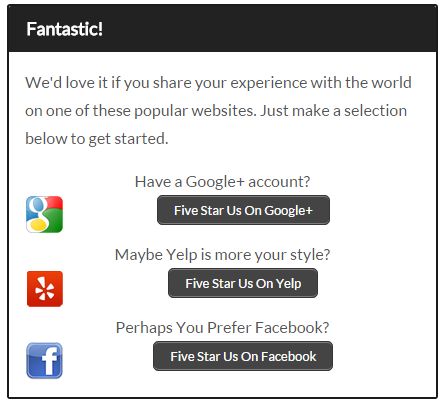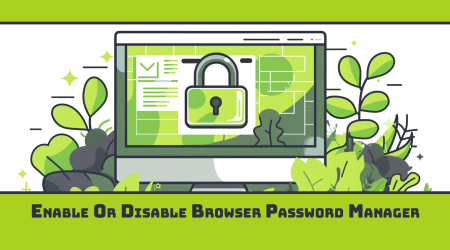If you were to look at MSPs (or just small businesses as a whole) you would probably find most lack refinement in terms of customer follow-up, collecting testimonials, and spotting and resolving unhappy clients. It is very easy to move on to the next thing on your agenda at the end of a customer interaction. Unfortunately, your client might not be finished with you when you are finished with them. Closing a ticket, or ending a sale still might leave your customer hanging and they may have more to say.
It could be negative feedback or positive feedback. But you just won’t know unless you ask. Clients can be brutally honest both in negative and positive feedback.
A “Review Gate” is a (mostly psychological) way to trap negative feedback from your clients into a private behind the scenes conversation and allow positive feedback go public in third party channels (such as Google Places, Facebook, or other honest third party review websites).
Here is an example of one:

When you are finished interacting with a client, you can send them to this very simple page. They can make a choice between saying that they did not like or they did like your company’s work. Negative is placed first to make sure it is easier to spot.
 If a customer has a negative interaction, then they are taken to a specific form. This form allows them to voice their concerns and choose if they wish to remain anonymous. Negative feedback is bound to happen if you are in business long enough even if you pride yourself on good customer service!
If a customer has a negative interaction, then they are taken to a specific form. This form allows them to voice their concerns and choose if they wish to remain anonymous. Negative feedback is bound to happen if you are in business long enough even if you pride yourself on good customer service!
The negative interaction form does three primary things:
- It gives your customer a chance to burn off pent up steam. Sometimes they will respond with a cool head, but often they can be vicious and your feedback form could become a lightning rod for anger that your customer has pent up against your company (and possibly probably other things going on in their life). If they blow the steam off here, the only person who has to hear it is you. This protects your public reputation because they will expend their anger in private.
- It gives you a chance to learn. When a customer is unhappy, you can take a step back and review if this was something you could avoid in the future. You want all your clients to be happy, and so any way you can improve your customer satisfaction overall is a win for your company. Try not to take anything they say here personally. This is a chance to learn and improve in a (relatively) safe environment.
- It gives you a chance to perform “Service Recovery”. There is a whole industry built around the concept of Service Recovery and I highly encourage you to read up on it. The long and short of it, though, is that if you fix what made your customer angry they will often become better customers than those who never had a problem with your company. People want to feel heard. Building a feedback and service recovery process into your company can help turn angry customers into staunch supporters who will actively praise you everywhere they go.“They really listen to me and went above and beyond to make sure that my needs were met” is something you might hear from a client who has been through a successful Service Recovery process.
 The positive form is different. You want to hear the feedback but often happy customers will say nothing constructive which you can learn from. Instead they just want to wave the banner of your company and will say things that pump your ego.
The positive form is different. You want to hear the feedback but often happy customers will say nothing constructive which you can learn from. Instead they just want to wave the banner of your company and will say things that pump your ego.
“Matthew spent hours working on our machines and completely resolved our network issues within the first week of working with us!” This is great feedback, but it would be a huge waste if a review like this went somewhere private in some feedback form. That only means that the people internal to your MSP would know that your client is happy with your work.
Instead, the positive feedback process leads the client to a choice of places where they can leave a very public review of your company. Negative feedback is filtered out (“Gated” by the Review Gate) and positive feedback is forwarded to a list of your favorite review websites.
It is best to pick three sites at the most so you don’t overwhelm them with choices. But if you make it as easy as possible to leave a review, you will find your public five star reviews increasing as happy clients find a place to sing your accolades instead of just thinking “good vibes” in your direction.
Five star reviews will boost your SEO, improve your authority in the industry and your local market, give social proof (making sales easier to close), and grant a general momentum to your business you are probably not used to.
Have you ever taken the time to setup a process like this in your business? I’d love to hear your thoughts on this. Let me know in the comments section below ?.






